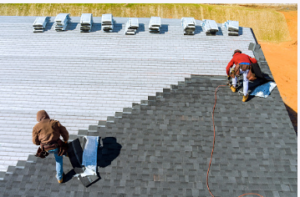If your roof leaks, quick solutions are available to help prevent further damage until professional help can arrive. Tarps may be one such quick-fix solution.
 To identify the source of a leak, recruit help entering your attic with a flashlight in hand and step only on secure framing members. Take measurements along your roof’s edge focusing on areas where water drips appear in your ceiling below, and run the garden hose up the roof from that point until dripping stops appearing below.
To identify the source of a leak, recruit help entering your attic with a flashlight in hand and step only on secure framing members. Take measurements along your roof’s edge focusing on areas where water drips appear in your ceiling below, and run the garden hose up the roof from that point until dripping stops appearing below.
Look for the Source
Step one in leaking roof quick fix Adelaide is to locate its source. It may take some effort, so planning and collecting materials such as two-by-fours, roofing tar, plywood or additional shingles before starting this task is wise. A nearby hardware store or home improvement centre should have everything needed for your quick roof fix project.
Leaks tend to form around areas where different planes intersect on the roof or where penetrations, like plumbing vents, chimneys, dormers and skylights, meet, such as plumbing vents or chimneys, dormers or skylights. Broken or overly exposed shingles, deteriorating flashing and poorly sealed or corroded nail holes often source roof leakage. With attic access, locating these spots should be relatively straightforward; look in with a bright flashlight while walking carefully along framing members rather than insulation or ceiling below.
Tarp the Area
As soon as a hole in your roof becomes apparent, an easy way to protect it and its contents from water intrusion is by covering it quickly with plastic sheeting – an inexpensive and accessible solution that could also come in handy when painting, oily or grease-based projects are underway in your house. Plastic sheets come cheap and easily accessible – you may already have one lying around if painting projects take longer than expected or oil spillage occurs.
Before securing the tarp to do a leaking roof quick fix Adelaide, use a flashlight to inspect any affected areas of your roof for moisture, such as darkness or mould growth, which will allow you to pinpoint where exactly the issue lies as well as any extensive damage which requires more extensive repair efforts.
Contain the Water
If you have attic access, place a bucket or other container below the area where water leaks to catch it. Otherwise, use water stains or musty odours as clues to track its source within your home.
If it’s hard to locate your leak, enlist help in the form of someone with a garden hose who can go up onto the roof with you and soak the area, starting low and moving upwards gradually over several hours – giving your helper time off and buying them dinner during this process can only help! Running water will reveal any discoloured felt or rotten wood, which helps pinpoint its source.
Tarping the area can help keep water from spreading across your attic and ceiling, which could result in more serious damage. If water collects on one ceiling area, punch a hole with an old screwdriver in its centre to help it drain more freely and reduce pressure on other parts. While this won’t solve your actual issue, this temporary leaking roof quick fix Adelaide measure should prevent bulges from accumulating further and let you see exactly what is going on on the roof for better resolution of problems in future.
Seal the Leak
An effective and quick solution to leaky roofs is a waterproof tarp, large enough to cover the damaged area and securely fastened. While not permanent, this temporary measure should keep water at bay.
Make time during the day to go into your attic or crawl space and inspect it more carefully, checking for dampness along framing members, discolourations or marks and signs of leakage. Also, inspect chimneys, vents, old flashing, skylights or any other components above your roofline that extend above it.
It can be tricky to identify the source of a leak if interior damage has been caused by a roof that leaks over an expansive area. Since water travels downward, its source could be some distance from where moisture or holes exist in your house.
